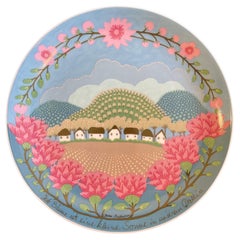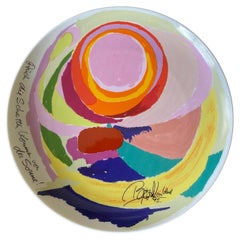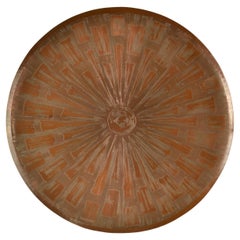Yvan Rabuzin Furniture
to
1
1
1
1
1
1
1
1
1
1
1
1
1
12,192
3,892
2,454
2,231
Creator: Yvan Rabuzin
Rosenthal Artist Edition Wall Plate No. 15, Naïve Nature by Yvan Rabuzin 1979-80
By Yvan Rabuzin, Rosenthal
Located in Andernach, DE
Artist wall plate No. 15 by Ivan Rabuzin, "Jede Blume ist eine Sonne in unserer Existenz". ø 310 cm (12,2''). Nr. 3975/5000
'Every flower is like a...
Category
Mid-20th Century German Mid-Century Modern Yvan Rabuzin Furniture
Materials
Porcelain
Related Items
Rosenthal Studio Line Porcelain Plate by Björn Wiinblad 'Limited Edition'
By Bjorn Wiinblad, Rosenthal
Located in Waddinxveen, ZH
Stunning wall plaque by Bjorn
Wiinblad for Rosenthal. The plaque was produced in 1975 in an edition of 5000, and this one is number 1328.
The text on the plate is German ‘auch die...
Category
1970s German Mid-Century Modern Vintage Yvan Rabuzin Furniture
Materials
Porcelain
Large Etched Copper Wall Plate by Valentien 1960's
Located in London, GB
Large etched copper wall Plate by Valentien 1960's. The abstract pattern is applied by hand and radiated from the centre like a flower.
Category
1960s European Mid-Century Modern Vintage Yvan Rabuzin Furniture
Materials
Copper
Rosenthal Parables 1982 "The Prodigal Son" Björn Wiinblad orig. sign Wall Plate
Located in Berlin, DE
Wall plate by the Danish designer Bjørn Wiinblad for Rosenthal made of metal wall mounted sheet lacquered in black and gilt with glass faceted frosted Art Glass.Limited edition from ...
Category
20th Century Yvan Rabuzin Furniture
Materials
Crystal
$1,372 Sale Price
20% Off
H 1.19 in Dm 11.82 in
Beautiful Collectible Plates Bjorn Wiinblad, Rosenthal, Germany, 1970s
By Rosenthal, Bjorn Wiinblad
Located in Bastogne, BE
Beautiful decorative plates designed by renowned Danish artist Bjorn Wiinblad for Rosenthal.
Germany. 1970s.
Porcelain plates from the end of the 20th century based on the fair...
Category
1970s German Vintage Yvan Rabuzin Furniture
Materials
Porcelain
Victor Vasarely Rosenthal Studio Line Limited Edition Porcelain Plate
By Rosenthal
Located in Bochum, NRW
Victor Vasarely Rosenthal Studio Line, limited edition of 5000 pieces, no.: 4020, in unused, flawless condition.
Rosenthal artist plate No. 13 - "Live and let live - love and let lov...
Category
1970s German Vintage Yvan Rabuzin Furniture
Materials
Porcelain
Post Modern Rosenthal Art Glass Bowl by Eric J Roush
By Rosenthal
Located in San Diego, CA
Beautiful and graphic oval glass art bowl by Rosenthal. This beautiful piece from the late 90s is graphic and detailed. It shares yellow and amber tones along with a smoke purple ton...
Category
1990s American Post-Modern Yvan Rabuzin Furniture
Materials
Glass
Gianni Versace For Rosenthal le Voyage de Marco Polo Porcelain Plate
By Gianni Versace, Rosenthal
Located in Moreno Valley, CA
Gianni Versace "le Voyage de Marco Polo" for Rosenthal.
Designed in Italy by Gianni Versace for Rosenthal. "Le voyage de Marco Polo" porcelain service plate with gold decoration, bri...
Category
Late 20th Century Italian Chinoiserie Yvan Rabuzin Furniture
Materials
Porcelain
JAMES RIZZI "City People" Rosenthal Germany Collectible Plate Limited Edition
Located in Moreno Valley, CA
JAMES RIZZI "City People" Rosenthal Germany Collectible Plate Limited Edition.
1970s Rosenthal collectible porcelain plate 'City People', designed by James Rizzi,
Executed by Rosenthal, Germany, limited edition, no./1500
Limited edition, signed and numbered.
Framed plate is in excellent condition, plate size is 12".
Frames is not in good condition, white became yellowish shows wear.
About James Rizzi: AMERICAN, 1950-2011
James Rizzi (October 5, 1950 – December 26, 2011) was an American pop artist who was born and raised in Brooklyn, New York.
Best known for his vibrant, youthful graphics and his three-dimensional prints. He was the official artist for the 1996 Olympic Games in Atlanta, adorning the famous logo with his noodle-like drawing style.
Rizzi was most famous for his 3D artwork, "especially the large, elaborate prints and teeming anthropomorphic cityscapes. His merry maximalism and delight in delirious detail and elaborate minutiae created a true art brand, a trademark style as recognizable as any in the world."
About Rosenthal:
German porcelain manufactory Rosenthal was originally founded as a ceramics-painting studio by Philipp Rosenthal Sr. (1855-1937) in 1879 at Schloss Erkersreuth in Bavaria, near the Czech border. Its first highly popular product was an ashtray inscribed with the words “Resting place for lit cigars.” In 1890, the company moved to the neighboring hamlet of Selb and, a year later, began to manufacture its own porcelain, since white porcelain was, at that time, in short supply. Rosenthal’s first complete table service was called Empire; it was exhibited along with other lines at Paris’s Exposition Universelle in 1900.
With the dawn of the 20th century, Rosenthal began producing porcelain tableware and services formed and decorated in the latest styles, like the Jugendstil Botticelli (1903), the Art Nouveau Darmstadt (1905), and the all-white Maria (1916) lines. Successes with this au courant approach led the company to launch an art pottery division in 1910, dedicated to luxury tableware, vases, and other decorative objects. By the 1930s, figurines were another important Rosenthal product, most notably the Disney-licensed Mickey Mouse pieces introduced in 1931.
In 1934, Philipp Rosenthal was forced to leave his company and country when his Jewish ancestry came under persecution by the Nazi regime. Despite the loss of its founder, the Rosenthal company remained the premier supplier of high-quality porcelain tableware to the Third Reich. After the war, in 1950, Philip Rosenthal Jr. (1916-2001) joined his father's company as an advertising manager. By 1958, he had become its CEO, continuing his father’s vision to produce high-quality porcelain in line with progressive tastes. Through the rest of the 20th century, Rosenthal was the most commercially successful porcelain producer in Germany.
In the postwar era, Rosenthal’s most famous tableware lines have included 2000 by Raymond Loewy and Richard Latham (1954), Magic Flute by Bjørn Wiinblad (1959), Suomi by Timo Sarpaneva (1976), and Moon by Jasper Morrison (1997). The company has enjoyed many popular and critically acclaimed collaborations with designers and brands, like Salvador Dalì, Tapio Wirkkala, Walter Gropius, Andy Warhol, Ron Arad, Enzo Mari, Konstantin Grcic, and Versace.
Rosenthal's product lines have encompassed more than ceramics over the years. In 1972, the company began producing furniture, under the subsidiary Rosenthal Einrichtung, in Espelkamp, Germany. Standouts from this arm of Rosenthal include Gunter Ferdinand Ris and Herbert Selldorf’s futuristic Sunball Lounge Chair (1969), Verner Panton’s Relaxer Rocking Chair (1974), Burchard Vogtherr's Vario Pillo...
Category
Late 20th Century American Expressionist Yvan Rabuzin Furniture
Materials
Porcelain
$349
H 17.75 in W 16.75 in D 2.25 in
Vintage Bjorn Wiindblad Decorative Plate 1001 Nights Lute Player Plate
By Bjørn Wiinblad, Jonathan Adler, Rosenthal
Located in San Diego, CA
Beautiful collectible plate from the famous Danish artist Bjorn Wiinblad (Bjørn Wiinblad). The plate was designed for Rosenthal, Germany and is deco...
Category
1970s German Mid-Century Modern Vintage Yvan Rabuzin Furniture
Materials
Gold Leaf
$148 Sale Price
26% Off
H 7.45 in W 7.5 in D 1 in
Large Artist Ceramic Wall Plate with Horse Motif by Helmut Schäffenacker / Ulm
By Helmut Friedrich Schäffenacker
Located in Nürnberg, Bayern
Artist ceramic wall plate with horse motif by Schäffenacker / Ulm. Handmade made in Germany.
Category
1960s German Mid-Century Modern Vintage Yvan Rabuzin Furniture
Materials
Ceramic
$887
H 26.78 in W 8.27 in D 1.58 in
Bjorn Wiinblad ALADIN in the Enchanted Garden Porcelain Plate by Rosenthal
By Rosenthal, Bjorn Wiinblad
Located in Moreno Valley, CA
Bjørn Wiinblad wall Plate, produced by Rosenthal.
ALADIN in the Enchanted Garden #4 Wall Plate Bjorn Wiinblad Rosenthal.
Vintage porcelain collector plate by Rosenthal Studio Line, Germany from the series " Aladin im Zubergarten" plate "Aladin und die Wunderlampe IV".
This decorative wall plate is titled "Aladin im Zaubergarten eingesperrt" (Aladin in the Enchanted Garden) and is number 4 in the collectible series of 12.
The plate includes hanging hardware affixed to the back, shown.
The various colors, together with the gold, make these plates true and precious collector's items.
Bjørn Wiinblad porcelain Rosenthal Studio Line Collectable Plate.
In pristine condition.
Dimensions: 6.25 in. diameter.
Artist: Bjørn Wiinblad.
Plate Number: 4 (series of 12)
Title: Aladin in the Enchanted Garden
Hardware: Fixed, hanging.
Aladdin and the Magic Lamp series was designed in the 60s by the Danish artist and chief designer of Rosenthal, Björn Wiinblad.
Connoisseurs of Wiinblad's work know that this great artist worked in various industries and fields in the 20th century and had his works in renowned museums such as the Victoria and Albert Museum in London, the Museum of Modern Art in New York, the National Museum in Sweden, were collected from the Moderna Museet in Copenhagen and today have a high collector's value.
Rosenthal is a German company that is well-known for its production of high-quality porcelain and other luxury goods. The company has a long history, dating back to the late 19th century, and it has collaborated with various artists and designers over the years to create unique and artistic pieces.
This Bjorn Wiinblad Vintage Danish Modern Rosenthal porcelain " Aladdin " collector's decorative plate is a very special and unique piece to add to your collection.
The porcelain collector's decorative wall plate is made by Rosenthal Studio Line, Germany from 1976 - 1982. Made of fine porcelain, the round decorative plate features a beautiful multicolor design of Aladdin with special metallic gold details. It is signed in the plate lower front and has an attached hanger on the reverse back side for easy wall installation.
Characteristics of Wiinblad's work include whimsical round faced people, dressed vaguely in 19th Century costume. They are often surrounded by natural elements : twining vines, floral wreathes, and fantastical trees. When Wiinblad employed color, he did so with great assurance. His color palette is saturated and strong, often accented with metallic gold or silver.
Bjørn Wiinblad was a Danish painter, designer, and artist known for his distinctive and whimsical style. He gained international recognition for his work, which often featured imaginative and decorative elements. Wiinblad was active from the mid-20th century until his passing in 2006.
Bjorn Wiinblad ( 1918 - 2006 ) was a Danish painter, designer, and artist known for his distinctive and whimsical style in ceramics, silver, bronze, textiles, and graphics. He gained international recognition for his work, which often featured imaginative and decorative elements.
His artworks have been exhibited internationally since the early 1950's. Wiinblad was named Man...
Category
Mid-20th Century German Expressionist Yvan Rabuzin Furniture
Materials
Porcelain
Rosenthal Studio Line Porcelain Relief Plaque by Natale Sapone 'Limited Edition'
By Natale Sapone, Rosenthal
Located in Waddinxveen, ZH
Stunning wall plaque by Natale Sapone. The plaque is "new" because it has been kept in its original box. The plaque was produced in 1972 in an edition of...
Category
1970s German Modern Vintage Yvan Rabuzin Furniture
Materials
Porcelain
$822
H 1 in W 14 in D 12 in
Yvan Rabuzin furniture for sale on 1stDibs.
Yvan Rabuzin furniture are available for sale on 1stDibs. These distinctive items are frequently made of porcelain and are designed with extraordinary care. There are many options to choose from in our collection of Yvan Rabuzin furniture, although brown editions of this piece are particularly popular. Many of the original furniture by Yvan Rabuzin were created in the mid-century modern style in germany during the mid-20th century. Prices for Yvan Rabuzin furniture can differ depending upon size, time period and other attributes — on 1stDibs, these items begin at $296 and can go as high as $296, while a piece like these, on average, fetch $296.


